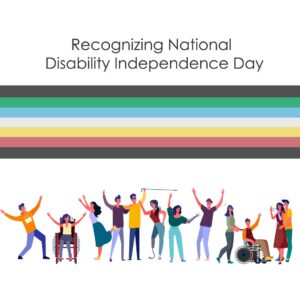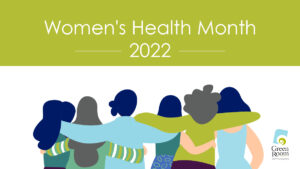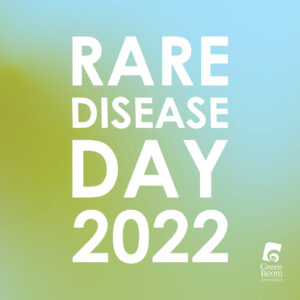 Today is National Disability Independence Day, commemorating the signing of the Americans with Disabilities Act (ADA) on July 26th, 1990 – a civil rights law that prohibits discrimination against individuals with disabilities in all areas of public life. At Green Room Communications (GR), not only do we strive to support those who live with a disability through our advocacy efforts, but we are committed to cultivating a culture of inclusivity and equal opportunity for our team members affected by a disability.
Today is National Disability Independence Day, commemorating the signing of the Americans with Disabilities Act (ADA) on July 26th, 1990 – a civil rights law that prohibits discrimination against individuals with disabilities in all areas of public life. At Green Room Communications (GR), not only do we strive to support those who live with a disability through our advocacy efforts, but we are committed to cultivating a culture of inclusivity and equal opportunity for our team members affected by a disability.
One of the most critical ways we do this is by leading with empathy and offering flexible, remote working options that enable our team members to balance their professional growth with prioritizing their, and their loved ones’, health and well-being.
According to a recent study by AARP and S&P Global, 75% of parents and family caregivers report a moderate or major increase in stress and 60% of women who juggle work and caregiving responsibilities are now providing more care than before the pandemic.
As we continue to seek ways to support our employees, we gathered the below insights from our team about their personal experiences caring for loved ones with disabilities while at GR.
LeighAnne Castimore, Executive Assistant
My son, Henry, is 12 and was diagnosed with autism at age two. It became abundantly clear within the first few years of diagnosis that working full-time, in-person, would be impossible. After the initial pandemic shutdown, I realized remote workplaces were gaining popularity and thought a remote option may be a good fit for me. I stumbled upon GR and learned during the interview that they supported remote roles even prior to the shutdown. It was comforting to know that this was a policy not created due to COVID, but one that was already part of their culture. GR understands and supports work/life balance more than any company I’ve ever worked for. I can tend to my son’s needs as they present and balance my work responsibilities. I heard GR’s Managing Partner, Deb Fowler, once say, “You can have it all!” and I say it all the time now. You really can have it all when you have the right support.
Maryanne Caruso, Consultant
I’m a caregiver for my elderly mother. I take her to all doctor appointments, manage medication, grocery shop and make sure she has meaningful social and wellness components in her life. She recently fractured her pelvis and will be in rehab for a while, and I will be navigating through this process as her advocate. My former role would have had me back in NYC without flexibility, compassion and empathy for my situation. Now, I have the flexibility to be productive in my career while making sure my mother gets to all appointments, gets the best care and has an engaging quality of life. One silver lining of the pandemic is that many other companies are now recognizing the importance of work-life balance, which we can all benefit from.
Allison Pishko, Senior Vice President of Client Navigation
My younger daughter has a rare genetic mitochondrial disease which resulted in her suddenly losing her sight at age 20. Once I returned to GR, after initially taking leave, the flexibility of their model provided me the opportunity to attend doctor’s appointments with my daughter while knowing I was able to return to my work when I had the opportunity, and that I had an incredible team that had my back when I needed to be out. The adage of “you never know what people are dealing with” is true, and in my case, my child developed a disability seven years into my career at GR. If this was not the flexible, supportive environment it is, I am not sure I would have been able to continue working here. I was always supportive of team members who needed to flex their time to take care of a child with a disability or special needs, I just never imagined I would have been one of them.
Jen Zoller, Vice President of Client Navigation
I’ve been with GR for just over two years and have never felt more strongly that I am in the right place at the right time. As a working mother of three kids, one with Down Syndrome, it is critical that I have a level of flexibility that allows me to manage work and life. Parenting a child with special needs requires advocating for your child, but also, advocating for yourself. Cutting out my commute time and being closer to my children’s daycare is a critical component that helps me get my work done and handle unforeseen appointments that pop up. Most importantly, it gives me a better peace of mind to focus on work, but pivot quickly if I ever need to. I’ll admit that working from home requires a tremendous amount of discipline, reliability, time management and effort to be engaged with your teams and clients. It is a privilege that I work hard to protect, because ultimately, I would not be able to do what I do without it. Lastly, I want to encourage people to, instead of focusing in on what people ARE NOT ABLE to do, focus on what they ARE ABLE to do so we are celebrating the individual’s abilities.
To join in recognizing and supporting the disability community, visit the ADA National Network to learn more.

 May is Women’s Health Month, and as a Women’s Business Enterprise National Council (WBENC)-Certified Women’s Business Enterprise, Green Room is always exploring new ways to strengthen our commitment to and support of the health and wellbeing of our team.
May is Women’s Health Month, and as a Women’s Business Enterprise National Council (WBENC)-Certified Women’s Business Enterprise, Green Room is always exploring new ways to strengthen our commitment to and support of the health and wellbeing of our team. Advocacy for rare diseases is at the core of Green Room Communications, and Rare Disease Day (RDD) gives us the opportunity to reflect on how we can spread awareness for people impacted by rare diseases. At Green Room, advocating for people with rare diseases is a part of our overarching mission of keeping patients and caregivers top of mind in our healthcare communications work. To recognize RDD, we asked our team to share why raising awareness for rare diseases is so important to them – starting with our agency founder’s Deborah Fowler and Karen Carolonza who have close ties with the rare disease community both personally and professionally.
Advocacy for rare diseases is at the core of Green Room Communications, and Rare Disease Day (RDD) gives us the opportunity to reflect on how we can spread awareness for people impacted by rare diseases. At Green Room, advocating for people with rare diseases is a part of our overarching mission of keeping patients and caregivers top of mind in our healthcare communications work. To recognize RDD, we asked our team to share why raising awareness for rare diseases is so important to them – starting with our agency founder’s Deborah Fowler and Karen Carolonza who have close ties with the rare disease community both personally and professionally.
 Like many recent graduates during the COVID-19 shutdown, it was difficult to know where to turn to jump-start my career. However, after graduating with a degree in public relations (PR), I came across Green Room’s Fellowship Program that was designed to expose recent graduates to the healthcare communications industry and provide hands-on experience in preparation for a potential full-time position. As a graduate of the program — I’ve been a full-time Assistant Account Executive (AAE) since March 2021 — I am eager to share my experience for those looking to land their first PR job out of college, or who are looking to transition to a new career path in healthcare PR.
Like many recent graduates during the COVID-19 shutdown, it was difficult to know where to turn to jump-start my career. However, after graduating with a degree in public relations (PR), I came across Green Room’s Fellowship Program that was designed to expose recent graduates to the healthcare communications industry and provide hands-on experience in preparation for a potential full-time position. As a graduate of the program — I’ve been a full-time Assistant Account Executive (AAE) since March 2021 — I am eager to share my experience for those looking to land their first PR job out of college, or who are looking to transition to a new career path in healthcare PR.

 Are you at a deciding point about what’s next after graduation? If so, I encourage you to remain open to opportunity, take risks and try experiences outside of your comfort zone. As a rising college senior with NO IDEA of my future career path, embracing this mentality led me to an internship in healthcare communications at Green Room. Fast forward six years – I am now a Senior Account Supervisor leading multiple projects for pharmaceutical and biopharmaceutical clients and managing our Intern and Fellowship Programs.
Are you at a deciding point about what’s next after graduation? If so, I encourage you to remain open to opportunity, take risks and try experiences outside of your comfort zone. As a rising college senior with NO IDEA of my future career path, embracing this mentality led me to an internship in healthcare communications at Green Room. Fast forward six years – I am now a Senior Account Supervisor leading multiple projects for pharmaceutical and biopharmaceutical clients and managing our Intern and Fellowship Programs.
 Working Mom. The term comes with a sense of accomplishment and the ever-present wave of emotions. I cannot tell you I have it all figured out, but I CAN tell you how I have learned to create physical and mental space to focus on one thing at a time, one day at a time.
Working Mom. The term comes with a sense of accomplishment and the ever-present wave of emotions. I cannot tell you I have it all figured out, but I CAN tell you how I have learned to create physical and mental space to focus on one thing at a time, one day at a time. One year into working from home and here we are: braver, stronger, and more connected than ever. While COVID-19 tested companies’ remote work abilities, Green Room did what we already do best — we pivoted (word of 2020!) to elevate our existing infrastructure. Along the way, we uncovered important insights.
One year into working from home and here we are: braver, stronger, and more connected than ever. While COVID-19 tested companies’ remote work abilities, Green Room did what we already do best — we pivoted (word of 2020!) to elevate our existing infrastructure. Along the way, we uncovered important insights.














